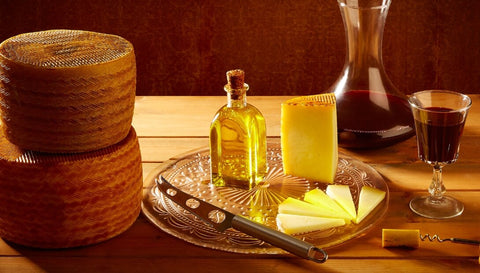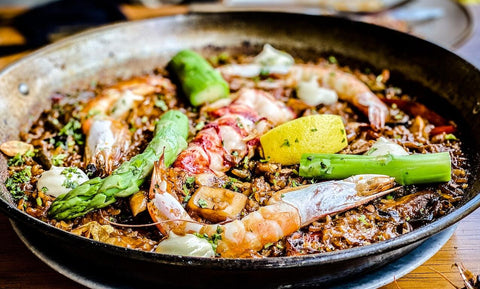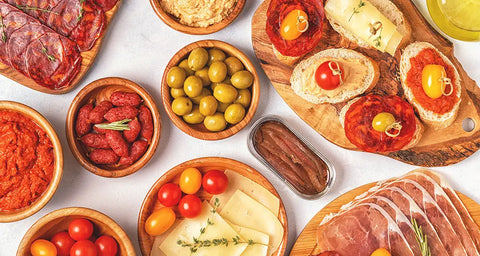History and Origin of Manchego Cheese
The origins of Manchego cheese stretch back millennia. The high, flat lands of La Mancha, a historic region in central Spain, have been home to Manchega sheep for centuries. The earliest documented references to a cheese produced in this region date back to Roman times, indicating that the cheese-making tradition in La Mancha has at least two thousand years of history.
In the Middle Ages, this cheese played a significant role in the local economy, and its production and trade were regulated by specific laws and ordinances. The popularity of Manchego cheese only grew over the centuries. In literature, Miguel de Cervantes' famous character, Don Quixote, mentions Manchego cheese in his work "Don Quixote de la Mancha", demonstrating the relevance of this product in everyday life at the time.
Official recognition of the excellence of Manchego cheese came in 1975, when it was granted the Protected Designation of Origin (PDO). This designation ensures that only cheeses produced in the La Mancha region, following traditional methods and using Manchega sheep's milk, can bear the name of Manchego cheese.
Manchego cheese is, therefore, a product with a long and rich history, closely linked to the land and culture of La Mancha. Its production has been passed down from generation to generation, and each cheese is a testament to this centuries-old tradition. A slice of Manchego cheese is not just a delicious food, but also a piece of the history and culture of Spain.
Production of Manchego Cheese
The production of Manchego cheese is an art that combines traditional methods with modern quality controls. The process begins with the collection of milk from Manchega sheep, a native breed of La Mancha that has perfectly adapted to the region's climatic and geographical conditions. Only the milk from these sheep can be used for the production of Manchego cheese under the Protected Designation of Origin.
Once collected, the milk undergoes a fermentation process with rennet, an enzyme that causes the milk to coagulate. This coagulation is carried out at a controlled temperature to ensure the consistency of the final product.
The resulting curd is cut into small pieces and pressed to remove the whey and form the curds. These curds are then placed in special molds that give the cheese its characteristic shape, including the famous "herringbone" pattern on the crust, which is a distinctive feature of Manchego cheese.
The cheese is then salted in a brine, which helps to preserve the cheese and develop its flavor. After salting, the cheese is left to mature in controlled cellars, where the temperature and humidity are kept constant to allow for proper maturation. The maturation time can vary from 30 days to 2 years, depending on the variety of Manchego cheese being produced.
During maturation, Manchego cheese develops its unique flavor and texture, with notes ranging from the sweetness of sheep's milk to the stronger, more complex flavors that develop in the more matured cheeses.
In summary, the production of Manchego cheese is a careful and detailed process that requires a great deal of knowledge, experience, and passion. The result is a cheese with an unmistakable personality, reflecting the traditions and terroir of the La Mancha region.
Varieties of Manchego Cheese
Manchego cheese is primarily classified according to its maturation time. This time not only affects the texture of the cheese, but also its flavor and aroma. Here are the main varieties:
-
Fresh Manchego Cheese: This cheese is matured for a minimum of 30 days, mainly for cheeses made with pasteurized milk. It has a soft and creamy texture, with a slightly acidic and fresh flavor. Its crust is flat and white or light ivory in color.
-
Semi-cured Manchego Cheese: This cheese is matured between 3 and 6 months. It has a firm but still quite tender texture, with a more developed yet still mild flavor and a bit of acidity. The crust is brown and has the characteristic herringbone pattern.
-
Cured Manchego Cheese: This cheese is matured between 6 and 12 months. It has a firm and compact texture, with a full and deep flavor that perfectly balances the sweetness of sheep's milk and a slight piquancy. The crust is dark brown in color.
-
Old Manchego Cheese: This is the Manchego cheese with the longest maturation time, more than a year. It has a hard and granular texture, with tyrosine crystals that give it a pleasant crunch. Its flavor is very intense, complex and persistent, with notes of nuts. The crust is very dark brown, almost black.
- Black Garlic Manchego Cheese: This is a unique and exciting variety of Manchego cheese that incorporates black garlic into the cheese-making process. Black garlic, which is regular garlic that has been aged and fermented until it turns black, imparts a sweet and savory flavor profile with hints of balsamic vinegar and tamarind. When combined with the rich and creamy flavor of Manchego cheese, the result is an incredibly flavorful cheese with a distinctive and memorable taste.
Each of these varieties has its own characteristics and charm, and all of them are a showcase of the art of making Manchego cheese. Regardless of their degree of maturation, Manchego cheese is always a true pleasure for the senses.
Manchego Cheese in the Kitchen
Manchego cheese is incredibly versatile in the kitchen and can be used in a wide range of dishes. Here are some ideas:
-
Cheese Boards: Manchego cheese is a classic on any cheese board. You can pair it with a variety of nuts, honey, jams, fresh fruits, and wines to highlight its flavor.
-
Salads: Manchego cheese can be an excellent addition to salads, whether grated or in small cubes. Its distinctive flavor can enhance any mix of ingredients.
-
Tapas: In Spain, Manchego cheese is a common component of tapas. It can be served alone, in thin slices, or it can be combined with other ingredients, such as Serrano ham.
-
Cooked Dishes: Manchego cheese can be an excellent ingredient in a variety of cooked dishes, from pastas to gratins. It can also be used in sauces, where it provides a smooth texture and a delicious flavor.
-
Desserts: Yes, you read that right! Manchego cheese can also be a great complement to desserts. It pairs wonderfully with honey and fruits and can be an interesting alternative to cream cheese in cheesecake recipes.
Manchego cheese can bring a unique touch of flavor to any dish. Its versatility in the kitchen is one of the aspects that make it such a cherished cheese. We encourage you to experiment with it in your recipes and discover the many ways it can enhance your dishes.
Conclusion
Manchego cheese is truly a culinary treasure, carrying with it the rich history and traditions of the La Mancha region. Its distinct flavor profile, which ranges from mildly acidic to complex and nutty, depending on its maturation, makes it a favorite among both cheese aficionados and casual consumers.
Whether enjoyed on its own, paired with fruits and wines, or used as an ingredient to enhance the flavor of various dishes, Manchego cheese never fails to deliver a unique and enjoyable tasting experience. Its versatility in the kitchen and its ability to elevate any dish it's added to is truly remarkable.
In the world of cheese, Manchego stands out as a testament to the art of traditional cheese-making. Each wheel of Manchego cheese embodies the dedication and passion of the cheese-makers, the unique characteristics of the Manchega sheep's milk, and the influence of La Mancha's terroir.
When you savor a slice of Manchego cheese, you are not just enjoying a simple dairy product, but also partaking in a culinary tradition that dates back centuries. This is the magic of Manchego cheese – a piece of edible history that continues to delight palates around the world.





